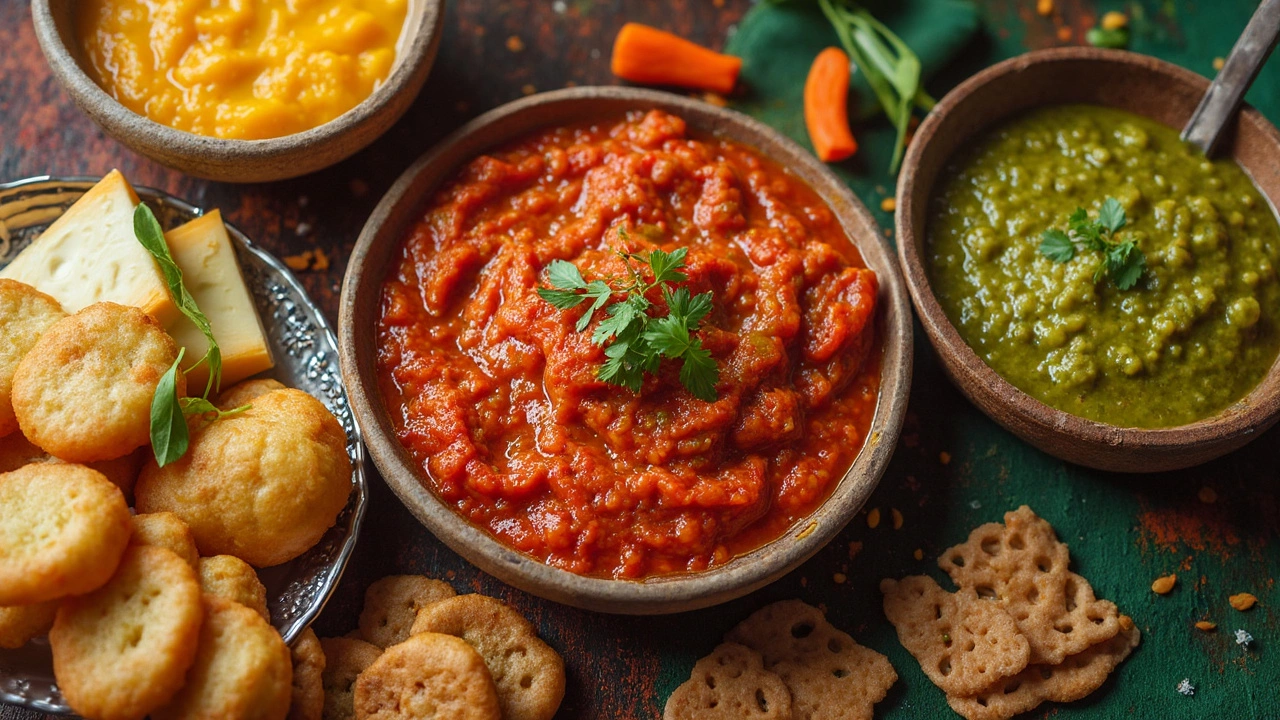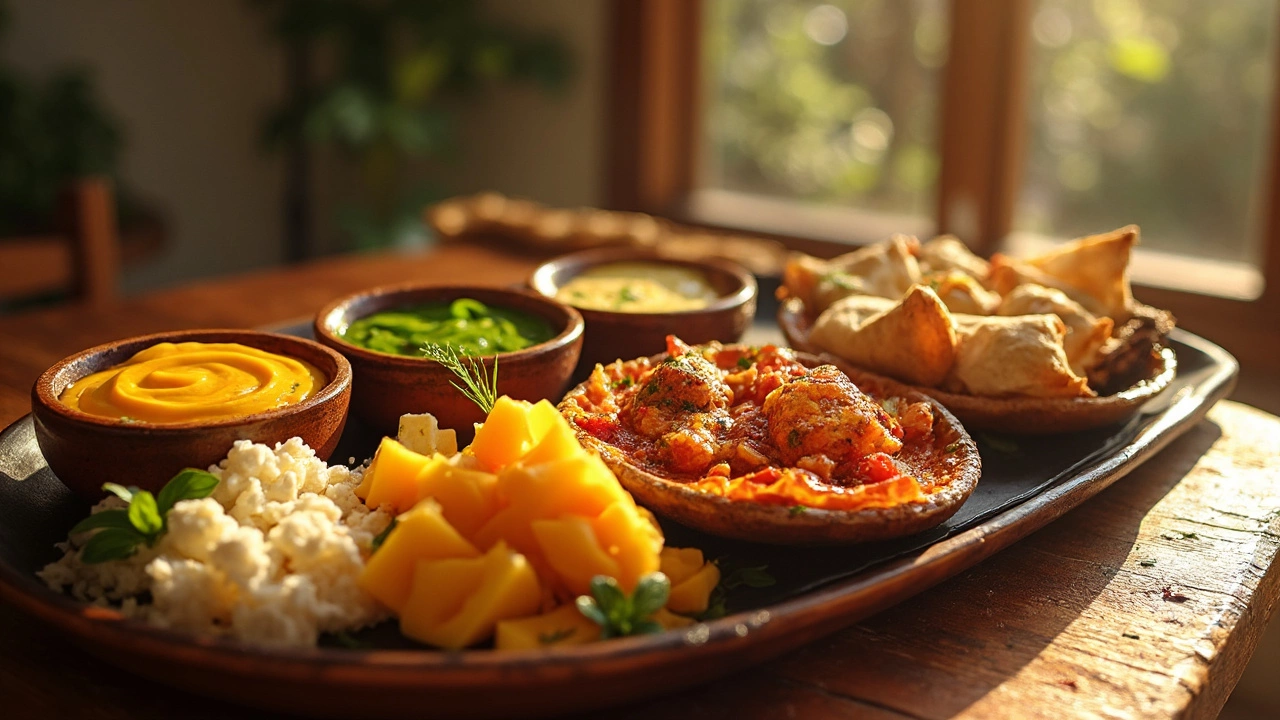Ever wondered if you’re supposed to spoon chutney straight from the fridge or warm it up first? You’re not the only one. This is hands-down one of the most common questions people ask after making or buying a jar of the good stuff. There’s no shame in not knowing—chutney comes from traditions all over the world, and each one does things a bit differently.
Thing is, temperature isn’t just about comfort. Warmth can bring out deeper flavors, while cold chutney can add a sharp kick against hot or rich foods. So, it actually makes a difference in how your dish tastes. If you’ve never tried both ways, you might be missing out on a totally new side of your favorite chutney. Let’s clear up the mystery and make sure you get the most flavor every time you pop that lid open.
- The basics: What is chutney?
- How temperature affects chutney
- Classic pairings: When to serve warm or cold
- Storing and reheating chutney
- Top tips for serving chutney right
The basics: What is chutney?
If you’ve ever eaten Indian food, you’ve probably seen some sort of chutney on the side—usually a colorful sauce or relish. Chutney is basically a blend of fruits, vegetables, spices, sugar, and sometimes vinegar. It can be chunky or smooth, sweet or spicy, and it’s usually served as a condiment to add a punch of flavor. People first made chutney in India over 2,000 years ago. British traders loved it so much they took it home and mixed up their own versions, which is why there are now so many types in supermarkets, especially in the UK and US.
There’s a ton of variety out there. Some common chutneys are:
- Mango chutney – sweet, with a bit of heat, and goes great with curry or cheese platters.
- Mint chutney – fresh and spicy; usually green and paired with grilled meats or samosas.
- Tomato chutney – tangy and sometimes smoky; pairs well with roasted dishes or sandwiches.
- Coconut chutney – common in South India, perfect for dosas and idlis (kind of like pancakes or rice cakes).
The most important thing to know is that chutney isn’t one-size-fits-all. Some are cooked for hours and taste rich and jammy. Others are just blended raw ingredients and hit you with real freshness. It’s all about what you’re pairing it with and what you want from the flavor.
Here’s a quick comparison table of popular chutney types and what they’re usually made of:
| Chutney Type | Main Ingredients | Typical Flavors |
|---|---|---|
| Mango | Mango, sugar, vinegar, spices | Sweet, tangy, spicy |
| Mint | Mint, cilantro, green chili, lemon juice | Fresh, herby, spicy |
| Tomato | Tomato, onion, mustard seeds, chilies | Tangy, savory, little sweet |
| Coconut | Coconut, green chili, ginger, yogurt | Creamy, mild, aromatic |
No matter which type you pick, chutney’s real job is to wake up your taste buds and give a boring meal a twist. So, whether you like your chutney sweet, sour, or with enough spice to make you sweat, there’s one out there for you.
How temperature affects chutney
Temperature plays a bigger role in chutney than most people think. When you serve it cold, right out of the fridge, the flavors stay crisp and sharp. That works great for tangy or fruity chutneys—think mango or mint—because the chill keeps the zing front and center. Cold chutney also stays thicker, so it’s easier to spread on crackers or bread without making a mess.
Warm chutney is a different story. A gentle heat brings out hidden layers, especially in spicy or savory chutneys. Ever noticed how a tomato chutney or apple chutney over hot curry seems to mellow out and get richer? That’s not your imagination. Warming it up smooths out some of the sharpness and lets sweet or spicy notes come forward. Plus, a bit of steam carries aroma, which can make your whole meal smell more inviting.
The texture also shifts. Cold chutney can feel chunky or even a bit stiff if there’s a lot of sugar or fruit. Warm it, and you’ll notice it thins out just enough to pour or drizzle, which is perfect if you want it to soak into rice or potatoes.
- Cold chutney: Best for sharp, tangy flavors and chunky textures. Handy for cheese platters or quick snacks.
- Warm chutney: Best for deeper, mellow flavors and a pourable texture. Great for pairing with hot dishes or as a glaze.
If you’re using chutney as part of different recipes, changing the temperature is an instant way to tweak the whole dish. It’s worth experimenting to see what you like best. Just remember, not all chutneys taste great both ways—so try a little first before heating up the whole batch.

Classic pairings: When to serve warm or cold
There’s no single rule for serving chutney at a certain temperature, but the type of dish you’re pairing it with usually gives a pretty strong clue. Almost all chutneys will work at room temperature, but temperature really matters if you want to get the most out of your meal.
If you’re putting chutney on a cheese board or serving it with cold meats, keep it cold or at least let it come to room temp. A cold chutney gives a tangy, refreshing boost that balances rich and salty foods. That’s why you’ll see apple, pear, or mango chutney next to sharp cheddar or cold ham at parties. It’s all about that contrast.
When you’re serving something hot and comforting, like Indian curries, samosas, or roast meats, try warming up the chutney a bit. Just a few seconds in the microwave or on the stove is usually enough. Warm chutney blends with the rest of the meal, and you get deeper flavors, especially with spicier tomato or onion chutneys.
- Cranberry chutney with roast turkey? Heat it up so it melts a little into the meat.
- Mango chutney on grilled chicken or pork—warm or cold both work, but try it warm if you want a saucy feel.
- Tomato or tamarind chutney with samosas or pakoras needs only a gentle heat, not piping hot, so you don’t overpower the snack.
- With bread, like naan or parathas, room temperature works best. Cold chutney can be too jarring, hot can make bread soggy.
Bottom line: If you want chutney to ‘pop’ and stand out, serve it cold. Want it to blend and mellow into the meal? Warm it up. Don’t be afraid to mix things up—some people swear by cold mango chutney on hot curry, just for the contrast. The best advice is to try both ways and see what your taste buds like most.
Storing and reheating chutney
Okay, let’s get right to it—proper storage makes sure your chutney stays tasty and safe to eat. Whether you bought a jar at the store or whipped some up at home, how you stash it matters. Always keep any opened chutney in the fridge. Most chutneys will last 2 to 3 months this way, as long as you use a clean spoon every time. If it’s homemade, check if you followed a canning process; if not, fridge it straight away.
Freezing is another option for homemade batches, especially if you’ve made a big pot. Just spoon it into airtight containers, leaving a bit of space for expansion. In the freezer, chutney stays good for up to six months. Thaw it in the fridge before using—never on the counter, since that can make it spoil faster.
Now, what if you want your chutney warm with dinner? Reheating is simple but watch out for overdoing it, as this can mess with the flavors or cause burning. Just scoop the amount you need into a small saucepan and heat on low, stirring now and then. If you’re short on time, about 30 seconds in the microwave does the trick. Don’t forget: only reheat what you’ll use, because repeated heating and cooling can dull the taste and shorten shelf life.
Here’s a quick look at how long different chutneys keep based on storage method:
| Type | Fridge (opened) | Freezer | Pantry (sealed, store-bought) |
|---|---|---|---|
| Homemade (not canned) | 2-3 months | Up to 6 months | Not recommended |
| Store-bought (opened) | 3 months | Up to 6 months | Check label (6-12 months unopened) |
Before serving, always give your chutney a sniff and quick taste. If you notice any mold, fizzing, or weird smells, toss it out—don’t risk it. If you want a little secret for chutney longevity: always use clean utensils, tightly seal the jar, and never let crumbs or sauce sneak inside. A few seconds of care make a real difference in keeping your flavors bright and bold each time you open that jar.

Top Tips for Serving Chutney Right
Nailing the temperature and pairing of chutney can take your meal from just okay to totally next level. Here’s how to make sure your chutney does its job in the spotlight instead of just sitting on the side.
- Check the style. Sweet, fruity chutneys (like mango or apple) usually taste best cold, especially with cheese or cold meats. Spicy or onion-based chutneys shine when they’re warmed, bringing depth alongside hot curries or grilled meats.
- Don’t serve straight from the fridge. If your chutney’s been chilling, let it sit at room temp for 15-20 minutes. This takes the chill off, lets flavors come through, and keeps the texture nice—not gloopy or stiff.
- Warm gently if you want more aroma. Place a small bowl of chutney in the microwave for 10-15 seconds, or heat it gently on the stove. Don’t boil it—just warm. This works especially well for tomato or chili chutneys paired with hot dishes.
- Size matters. Use a clean spoon each time you serve chutney to keep it fresh and safe to eat. Double dipping brings in bacteria, which no one wants in a shared jar.
- Get creative with pairings. Spoon cold chutney onto burgers or wraps, or swirl warm chutney into grain bowls or over roast veggies. The swap can totally shift the flavor vibe of your dish.
When unsure, look at the warmth of your main dish. Matching temperatures often feels natural—cold chutney with cold snacks, warm chutney with hot food. But nothing’s stopping you from mixing things up to find what you love most.
| Chutney Type | Best Temperature | Typical Pairings |
|---|---|---|
| Mango/fruit-based | Cold or room temp | Cheese boards, cold meats, sandwiches |
| Tomato/onion/chili | Warm or room temp | Curry, grilled meats, rice |
| Green/coriander-mint | Cold | Snacks, samosas, pakoras |
One extra tip: Store chutney in small jars so you only open what you need—less chance of spoiling and easier to reheat or let come to room temp. Stash in the fridge after opening, and use within 3-4 weeks for best flavor and safety.
